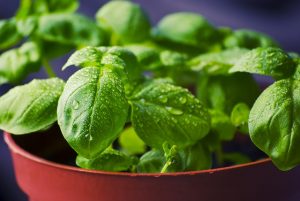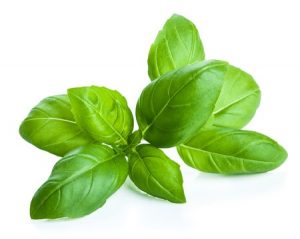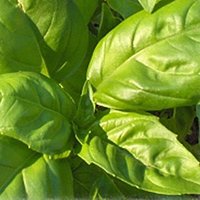If you want the best of friends with your summer tomatoes or a Greek salad then look no further than that great herb of the Mediterranean, basil. The other fantastic use is in the sauce known as pesto which is a combination of chopped basil with Parmesan cheese, olive oil, garlic, lemon and pine nuts. The sauce simply lights up an Italian pasta dish. I think of all the herbs to grow this might be one of the essential ones because of its versatility. It also lends itself well to all-year-round indoor growing.

Basil is in fact a bushy jungle plant from Asia that normally grows to between 2 or 3 feet in height. Conditions suited to a hot, humid climate should be ideal but it is really easy to grow and simple to maintain. We grow plenty in small pots in the greenhouse for the kitchen as an annual although it can be left as a perennial (apparently). But don’t let that stop you – window boxes, patio containers, tin cans – old boxes will suffice.
There are dozens of different excitingly-flavoured varieties which simply cannot be bought at the supermarket but can be sown for a crop all year around. Its soft bright green leaves make it a wonderful addition to the garden, especially the hot house. Why not try fragrant cinnamon, lime and even liquorice basils just to add an extra twist to a salad.
If you are interested, there are some fascinating medicinal properties associated with dried basil leaves (see article) which can be purchased.
There are four different types. The main species is Sweet Basil (Ocimum basilicum) from which a number of cultivars have been derived.
Sow: February to July. You are supposed to be able to sow all year round.
Harvest: July to October

Sowing Seeds
Sow the seeds indoors in small pots or trays onto the top of well watered free-draining compost throughout the year. Either press down into the compost or cover the seedlings with about 1/8″ inch of fine soil or vermiculite. Gently tamp the soil over the seeds and water with a fine spray. Water well and place in a warm position, usually a windowsill or greenhouse. This encourages maximum germination.
An alternative is to sow seeds in a tray and place in a propagator or seal inside a polythene bag.
The best time to sow is probably March when warmth can start to be felt in the earth (about 50°F). A typical germination temperature is anywhere between 15 and 25 Centigrade.
Growing Basil On
Seedlings appear in 7 to 14 days. Transplant into pots (7.5cm) if this wasn’t done before. The seedlings need to be large enough for this. Transplanting will halt growth for a while but accept this and the crop is still good! The pots should be moved to a slightly cooler and shadier place to avoid undue straggly and leggy growth.
Damping off can be a problem if the watering is too heavy but don’t leave them parched. Thin out seedlings and use any unwanted shoots and leaves in cooking.
Some basil varieties do grow outside, but these need to be hardened off so acclimatising the plants to cooler temperatures helps in this process. Remember, frost is a killer of these plants !
Transplant the basil seedlings when they are large enough to handle to their final growing position which is ideally a well-prepared bed in the sunny part of the garden or a large pot. The best soil is a fertile, sandy type which implies it is free-draining rather than a claggy soil.
Keep those seedlings between 12 and 18 inches apart. I prefer the greenhouse, under the shade of tomato plants. If it is grown outside as in a potager garden then position close to the lettuce beds and make full use of its ornamental look. Grow in patio pots, window boxes or windowsill boxes otherwise.
Make successional sowings so that a ready supply of leaves are available throughout the year.
Harvesting Basil
Harvest the leaves as and when required and this too is throughout the year although July to October appears the norm. Allow the plant to grow though to a size where you can spare enough to pick plenty. Collect from the tops of the branching points and cut off a several inches. Basil is delicate so handle carefully to avoid bruising and blackening the leaves.
Pinch out growing tips, especially the flowers to encourage bushy growth and it just prevents the plant becoming unruly. I know some who reduce the plant by half which seems severe however it does produce a very full bushy plant with plenty of leaves.
Continued Cultivation
Water and fertilize twice a month and use a fish based fertilizer to sustain growth. Water in the morning! Basil dislikes wet in the evening because grey mould (Botrytis) can afflict the growing plants with its unsightly greying fuzz. The plants soon die off if this mould gets hold.
Just make sure the basil continues to get plenty of sun. In the autumn and winter months the cloud cover will halt good growth.
Issues With Growing Basil
Basil is subject to a variety of fungal diseases, including Fusarium wilt, grey mould (see above) and black spot. It will also dampen off fairly easily. Avoid these problems by waiting to plant outside if possible until the soil has warmed by not overcrowding the plants. In the USA, there is a problem with Japanese beetles which can turn a leaf to just veins. The way to control is hand pick and get rid of by a suitable method!
[Please note we are an affiliate marketing partner and will make a sales commission if you purchase any items through our affiliate links. Please read our affiliate disclosure]

Varieties
‘Greek’, ‘Sweet’ (syn. Sweet Green), ‘Genovese’, ‘Mammoth Sweet’, ‘Lettuce Leaf’ and ‘Swiss Sunset’ are all successful cultivars to try out.
The ‘Sweet’ variety is available from UK seed suppliers such as Simply Garden, Unwins as well as Mr Fothergills.
The ‘Genovese’ variety has interesting and unusual serrated edges which give it such a distinctive and attractive look. This is one to add to tomato salads.
Simply Seeds offer ‘Genovese‘ seeds as well as D.T. Brown (Tel: 00 44 333 003 0869) who sell an unusual, small-leaved Greek basil called ‘Aristotle‘ (Height: 60cm/2ft). I also like the Purple-Leaved Basils such as ‘Red Rubin’ (Height: 60cm/2ft) which is an attractive, ruffle-leaved, deep purple-burgundy coloured type with a spicy, highly aromatic flavour and ideal as a complement to the green varieties. Another purple-leaved type is ‘Purple Ruffles’.
There are a number of scented-leaf basils. ‘Cinnamon‘ (Height: 60cm/2ft) offers a wonderfully fragrant, tagine-scented note with purple stems topped by fresh green leaves. We have some lemon-scented varieties such as ‘Lime‘, ‘Mrs, Burns’ and ‘Dani‘. You might also enjoy a slightly spicy type known as the Thai basil, ‘Siam Queen’. Another group to consider are the Dwarf basils which include ‘Spicy Globe’. It is green and grows to just 10-12 inches.
Kitchen And Culinary Use
All the leaves are used in salads and pasta sauces. One of the most famous is pesto which is a combination of basil and pine nuts with parmesan cheese in olive oil.
Any of the tougher parts such as the stems form a mix with bouquet garni (basil stems, three stalks of parsley, a stem of thyme and a bay leaf) which are used in soups and broths. Basil also works well with strawberries by adding a slightly spicy background and is a good mix in lemonade.
To keep basil for cooking, you can air-dry it in small, loose bunches. It keeps best though when frozen in cubes of ice. The alternative freezing method is to prepare a puree from washed leaves in a food processor or blender. Add enough cold water to make a thick paste but capable of being poured. Pour the puree into ice-cube trays and freeze, then place in the freezer. Once they have formed cubes just place in labeled freezer bags and use as needed in soups and sauces.